BRIONI alias BRIJUNI ARCHIPELAGO
at the south
western coast of Istria Peninsula
Zvonko
Springer, Salzburg, Austria, 1999
on this web with kind permission, 2005
Introduction
The peninsula of ISTRIA was under
the Italian sovereignty between the two World Wars. There were two
access routes one by railway and the other by road that led from
the Kingdom of Yugoslavia into Istria. The railway
started at Ljubljana (Slovenia) to Postojna
station at the boarder to Italy. At the rail crossing St. Peter one branch
led to Rijeka (Fiume, ital.)
and the other one to Divaca rail crossing where it branched of to
Trst (Trieste, ital.)
and the other branch continued via Brest (Buzet),
Pazin, Kanfar to Vodnjan and Pula (Pola,
ital.). From City of Triest another railway line linked Koper, Izola,
Piran, Buje and Porec where it ended – this line doesn’t exists anymore
now. All afore mentioned railway lines were built by the Austro-Hungarian
Monarchy before 1914. The only railway line that exists today is
with the connection to Pula and with
a link to Rijeka.
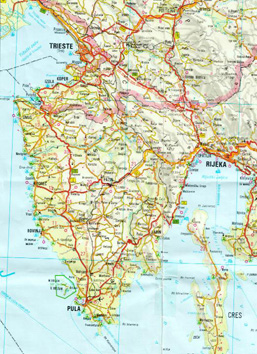
The map at left shows ISTRIA Peninsula and a wide line marks
the border between the Republics of Slovenia at north of Croatia.
At upper left is a narrow strip of Italian territory with City
of Triest at its right end. City of Rijeka (Fiume) is an importnat
Croatian harbor of northern Adriatic Sea (right
centre) now.
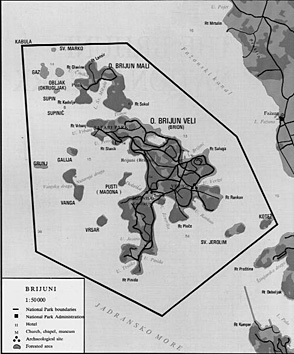
BRIJUNI
alias Brioni Archipelago on the map above is located
north-west of not far away from the City of
Pula. Pula (Pola) was an important harbor during the
times of Austro-Hungarian monarchy and later when
Istria including Rijeka came under the Italian sovereignty
that lasted until end of World War II.
The main roads follow almost exactly the railway lines as the same during
Italian occupation of Istria. At that
times one could cross on road at Sušak to Rijeka (Fiume, ital.)
over a wide bridge and that was the only second boarder crossing from Yugoslavia to Italian
Istria. The road along Istria’s eastern
coast passes through Opatija (Abbazzia, ital.) ending at Brestovo, where
would cross Vela Vrata Channel by a ferry-boat to get onto Cres Island. Another
road branch leads from Rijeka to Pazin
where it joined the main northern road continuing to Vodnjan and Pula following
to the same railway line. Thus, the main communication lines passed in
Istria across the central plateau with short side roads leading to the
cities on the Istrian western coast.
When
the Second World War ended in May 1945 a strong political hick hack
erupted regarding the Zones ‘A’ & ‘B’ at the north-west corner
of Istria. In 1949 Brioni alias Brijuni
Archipelago was nominated the restricted zone and it became the seaside
residence of Marshal Tito. The war ruins on the Islands had been cleared and one had started
the restoration and extention works of the whole infrastructure including
communications and waterworks. The renovated hotel buildings and
the rejuvenation of parks brought back the pleasantness pf staying
on the Archipelago again. Two new large buildings were constructed
on Veli Brijun western shore known as “White Villa” (1953) and “Brionka”
(1957) for the State’s highly regarded guests. The Yugoslav Government
built a single-storey villa on the Vanga Island (Krasnica now) west of Veli Brijun Island for Marshal Tito’s personal use. On southern
part of Vanga an orchard and a vineyard had been put up that contained
an interesting wine cellar. During Tito’s times Vanga island was
a strictly prohibited zone and not accessible to tourists at all.
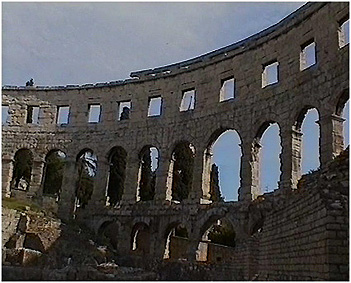 A part view of the famous AMPHITHEATRE interior
at Pula that is located next to the large Yacht harbor. A part view of the famous AMPHITHEATRE interior
at Pula that is located next to the large Yacht harbor.
In the late 1950s I have visited several cities in Istria like Koromacno
and Pula as well
as Porec and Rovinj on these travels. The travelling was rather tedious and
I had to use bus services to reach these remote places on my professional
trips then. The tourist trade was not well developed yet and the holidaying
visitors stayed in old hotels built at times of Austrian-Hungarian Monarchy.
These hotels existed mainly in places like Opatija, Lovran or Pula but there
were many camping places along the coast for those who had they own transport
means like cars that number steadily rose as from 1950s. I joined the Croatian
Society of Architects and Civil Engineers in Zagreb on a round
trip of Istria in spring
of 1958. Coming from Pula we had
to bypass Fažana near
Vodnjan and stopped at Limski Kanal (Channel), where we enjoined a perfect
seafood and fresh oysters grown there. That was to be the closes I came to
Brijuni Archipelago until my first visit there in May 2002.
GEOGRAPHY and CLIMATE of BRIJUNI ARCHIPELAGO
The Brijuni
Archipelago is located off the western shore of Istria and some
10km northwest of the town of Pula. BRIJUNI NATIONAL
PARK has a
total area of say 7.35km² of that
VELIKI (VELI) BRIJUN is the largest of all 14 islands with an area of 555.77
hectares. The National Park Brijuni has been established in 1983 and includes
the surrounding sea thus covering a total area of 36.3km². Mali
Brijun is the closest one to Veli Brijun having an area of 107.28ha, all
other 12 islands are much smaller like Krasnica (formerly VANGA) of 19.85ha
only.
Brijuni Islands maintain
the same biological and geomorphologic characteristics of the “Red Istria”.
The shallow Fažana Channel is 12km wide suggesting that the Brioni Archipelago
was part of Istria about
ten thousand years ago. The ice thaw caused sea level to raise creating
islands final shape with their many furrows so that their total coastline
amounts to 46.4km. Veli Brijun coastline is 26.6km, for Mali Brijun 8.2km
and Krasnica (Vanga) 3km only. The shores are mostly low and rocky and
accessible due to their horizontal stratification. The islands have horizontal
or slightly inclined Cretaceous limestone strata that are covered by thick
layers of carbonate brown or red soil (thus named "Red Istria”) in some
places. Some of the bays have shingle and sand.
Now-a-days view of Hotel NEPTUN with its modern
extension (right) and the old Boats House at left.
Brijuni Islands have the
northern Mediterranean climate characteristic to Istria west coast.
The temperatures vary between 5.9°C (January)
and 23.2°C during
summer months - the mean annual temperature is 13.9°C. The average annual
precipitation is 817mm but the snow is rare. The specific element of Istria west coast
is the rather high air humidity so that Brijuni have an average relative
air humidity of 76% that doesn’t fall below 70%. This is important for
the plants life on that part of Croatian coast whereas it is lower for
the rest of it particularly during the warmer periods there. The
rich indigenous flora has been largely improved by Paul Kupelwieser in
the early 1900s. When Marshal Josip Broz Tito choose Vanga (1947) as his
fleeting residence the Brijuni Archipelago became the restricted zone and
to be used by Tito’s visitors only.
FLORA and FAUNA of BRIJUNI ARCHIPELAGO
The fauna
of the archipelago consists mostly of Mediterranean and to
lesser degree of the several sub- Mediterranean species. The largest
areas are covered by macchia thicket; grass in park’s areas and with forested
areas of Holm-oak trees with laurel and of plantations of conifer on 18ha.
Most of the Holm-oak and laurel woods are found in the eastern part of
Veli Brijun. There are some smaller forests of broad-leaved phillyrea, strawberry
tree, turpentine
tree, mastic tree, laurustinus, myrtle and
tree heath. The woods
are full of almost impenetrable climbers like thorny smilax, fragrant
clematis, prickly
asparagus, interwoven
honeysuckle and evergreen
wild rose. Such complete
intermixed areas of Holm oak and laurel are the interesting feature of
the Brioni Archipelago found nowhere else along the Croatian Coast.
Views
along two main alleys of old Holm Oaks and Pine trees, the ancient
Olive tree in background left.
The smaller islands are almost completely covered by macchia of degenerated
Holm-oak forest. On Veli Brijun macchia changed under the influence
of game animals that eat climbers with no thorns. Macchia of some
8m height and too thick to look through grow on Peneda peninsula
(Veli Brijun) and on smaller islands like Vanga, Madona and Mali
Brijun. Besides domestic tree species there are many imported varieties
of pines named as stone, Aleppo, maritime and black, then cedar tree, Greek and Spanish fir, cypress, redwood, eucalyptus etc. Since 2nd World War
one have renewed and diversified the kinds of trees in parks particularly
when the Brioni Archipelago became restricted area as Marshal Tito's
residence.
The
cultivated landscapes are limited to the island of Veli Brijun and cover about 40% of its total
area. The best of park’s sections are around the hotels and villas, the
later mostly restricted to the public access yet. The present open grassland
and landscaped areas stand for the abandoned farmland that had been obtained
by successful extinction of malaria sickness early in 1900s. Paul Kupelwieser
bought the Brioni Archipelago in 1893 and started the demanding works to
turn Veli Brijun island into a tourist resort. Certain areas of macchia
and low woods were cut down and one spared larger and worthy trees including
few groups of Holm-oak. These isolated trees and ancient olive trees in
some places mark clearings and vistas today. Kupelwieser introduced few
larger animals like deer that pick up shoots and leaves at branches below
2m so the crowns look like "umbrellas" as shaped by clippers.
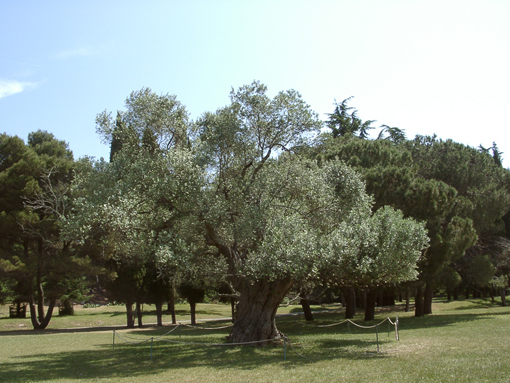
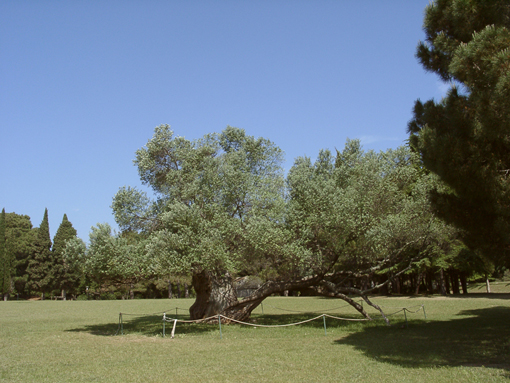
This
millenium old olive tree on Veli Brijun island is declared the National
Monument that is surrounded by Holm Oaks and Pine trees mostof them
planted by Paul Kupelwieser and Alojz Chufar.
The islands’
indigenous fauna had been lost on Veli Brijun in particular after one introduced
animals of game like deer, roe-deer, mountain sheep (Muflon) and hare around
1900s as well as an ostrich farm that existed there since 1910. During
the past 30 years one took more care about these animals and few more kinds
were imported like fallow and axis deer. In 1978 quarantine has been opened
to take care of some exotic animals like elephants, gazelles, antelopes,
zebras, llamas, camels etc. that Tito got as a present by his international
State’s guests. The acclimatization station became turned in a zoo-garden
with time but many of its enclosures are almost empty now. On the grassland
herbivores animals move around freely in a fenced-in so called “safari
park” at present. In the adjacent aviary one raises partridge and quail,
various parrots and cranes, black swans and flamingos where as pheasants
and peacocks live in the wild.

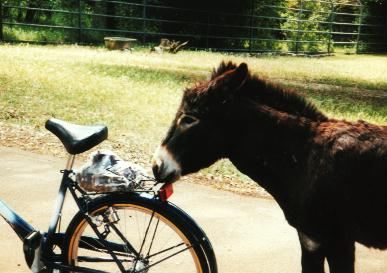
A large group of African zebras in
a unusual sorrounding of the Safari Park on Veli Brijun (left) and an
indigenous young donkey inspecting a plastic bag content at right.
There are
many indigenous birds and smaller islands are nesting places for seagulls,
terns, and doves. Brijuni
Archipelago is an important seasonal stopover for northern birds for marsh
birds is freshwater pond of Soline (Salina) on Veli
Brijun. Fishing is prohibited in Park’s wider sea areas with exception
of migratory fish swarms.
* * * * * *
A personal comment as
interlude:
Late in May 2002 we travelled by
car from Salzburg via Ljubljana to Buzet and from Lupoglav to
Pazin, Vodnjan on the Istria ‘Y’ new autobahn. At Vodnjan we
turned of onto a side road to reach Fazana where we left the car in the
hotel’s garage. Then we boarded the ship “Fazanka” for a 15 minute sail to Veli
Brijun. We’ve booked in the hotel NEPTUN and settled in its old part in
a spacious room cum anteroom and a balcony overlooking the harbor. Despite
a not too promising weather we enjoyed the pleasant and tranquil surroundings
thoroughly. We’d sleep long and refreshed undertook
several trips in e-buggy all over the island of Veli Brijun.
One day we have visited the small museum that is
located on Dr. Koch’s path behind the Hotel CARMEN. There I have learned
some interesting geographical and historical facts about Archipelago's
islands. My attention turned to the fascinating story of an Austrian
industrialist Paul Kupelwieser who significantly shaped and changed Archipelago’s
recent history. I had to learn more about this fascinating personality
and following paragraphs are the result of my study including most of
the photographs too.
* * * * * *
HISTORIC HERITAGE
The earliest
relics of human settlement date back to the mid-Neolithic about 3000 B.C.
The Histri, a western Illyrian tribe lived here in 2nd millenium B.C. and
remnants of five fortified hill forts were discovered on Veli Brijun. From
the Illyrian name “Brevone”
originates the present term for the Brioni (Brijuni) Archipelago. Romans
overwhelmed the Illyrians and ruled over Brioni and adjacent Istria after 177
B.C. Romans brought olive tree and grapes and several remnants of country
and farm buildings prove of their intensive agriculture on Veli Brijun.
The large ruins in Verige Bay are possibly
remains of the imperial Roman summer residences of 1st century A.D. There
was a palace with three terraces, three temples, and quarters for priests,
several baths with pools for warm and cold water, an aqueduct, sewage system,
farm buildings, quarters for servants and slaves, and a quay that is submerged
today.
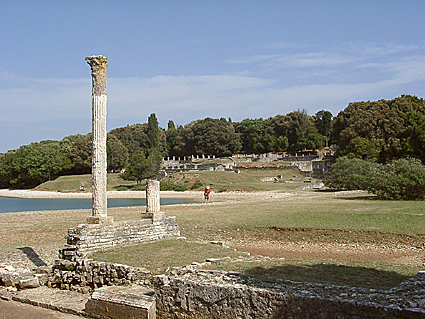
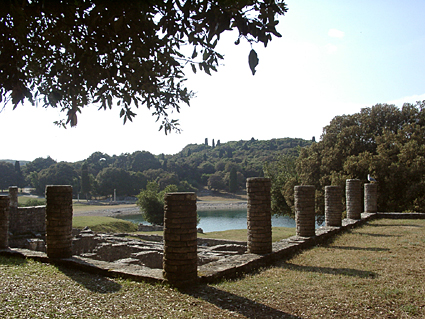
The luxurious rustic Roman castle built in 3 terraces
at the south shore of Bay Verige (left in background). At right a view
from one of castle's upper terrace down towards the Bay Verige.
The Byzantium ruled over
a Slav settlement on Brioni from 539 to 778 and the centre of life moved
to Veli Brijun western side in Dobrika Bay. A well-ordered
and fortified Byzantine Castrum has been built at the place of former Roman
villas on an area of 1ha. Material miscellany proves
that Romans, Goths, Francs, Byzantines, Slavs and Venetians lived on the
archipelago in an almost unbroken habitation from 2nd the century B. C.
to 14th century A. D. Next to the Castrum there are well preserved remains
of St. Mary’s basilica from 5th century and of a small church of St. Peter from 6th
century.

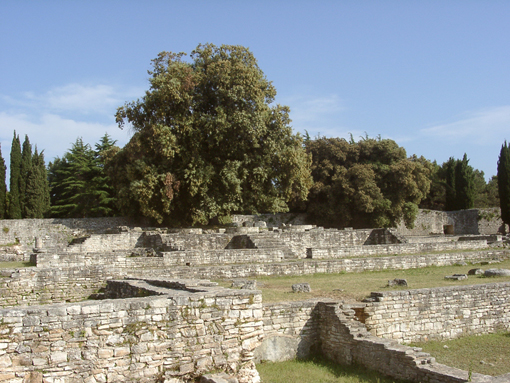
The
Byzantine Castrum built at western shore of Veli Brijun island with
a seaward view at left and towards the rear fortification wall with
a mighty Hom Oak tree inside the large compound at right.
Francs came
to the Archipelago after Byzantium that later
belonged to the Patriarch of Aquileia. The Benedictine abbey was constructed
in 11th century beside St. Mary’s church and a square fort, a donjon was
built on the eastern coast in 12th century. During those centuries of prosperity
the population in addition to farming produced salt (Saline Bay), quarried
and dressed stone particularly during Venetian times. Venetian rule began
in 1331 so the exploatation of stone and wood continued as well as the
salt production on the Archipelago that was owned by Venetian patrician
families. Several pestilences devastated the population like the first
plague in 1312 that reoccurred almost every 100 years of. The population
recovered rather slowly mostly due to the malaria illness that harassed
people regularly during the warmer periods. Venetians built two small places
of worship the St. Germaine’s chapel and the St. Rock’s votive church.
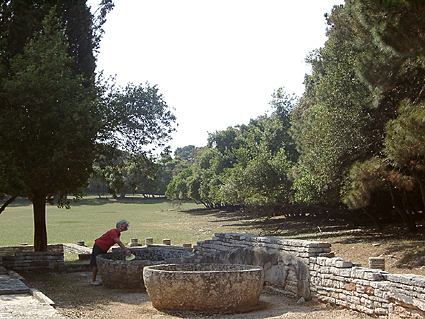

Views
of the two different but important hygienic facilities: Roman bath
tubs in Verige bay (left) and the large bath-room in Byzantine
Castrum (right) built in Gospe bay at west of Veli Brijun island.
As from
the late 17th century the Archipelago’s islands were actually deserted
except for temporary lumbers that came there to cut and to export wood.
As from 19th century the Austrian-Hungarian Monarchy started fortifying
the islands by building massive bastions and batteries. Two large forts
on Mali Brijun and other five ones on Veli Brijun had been constructed
for the defence of Monarchy’s main naval base at Pola (Pula) on Adriatic
Sea.
MODERN HISTORY – STORY OF PAUL
KUPELWIESER
The renaissance of the Brijuni
began in 1893 when Paul Kupelwieser (1872 - 1930), an ingenious personality
and retired Austrian magnate (manager of Vitkovice steel plant in Moravia), and who bought the Archipelago
from former Portuguese owners. He purchased a cow for a couple of care-taker
but the fodder had be brought in from Fažana like various other bits and pieces
needed for the living on island. Concurrently Kupelwieser started looking
for a suitable person to supervise and manage the works that were needed
to provide reasonable habitation facilities on Veli Brijun. He made a good
choice with an Istrian Alois Zuffar or Alojz C(h)ufar (1852 -1907) who
has been the most reliable and all-round person to be dedicated to this
pioneering task on Brioni. Paul’s son Karl joined Zuffar and stayed on
Veli Brijun while Kupelwieser went to England where he got very sick and nearly
died of an unidentified illness. During his long absence unwieldy woods
and thick macchia were cleared, the few existing buildings were made more
habitable and some new paths set out using plentiful of rubbles from manhy
abandoned quarries.
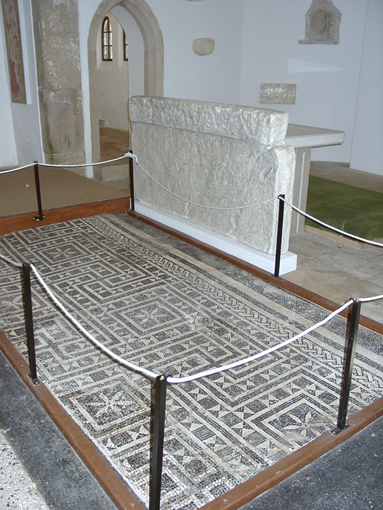 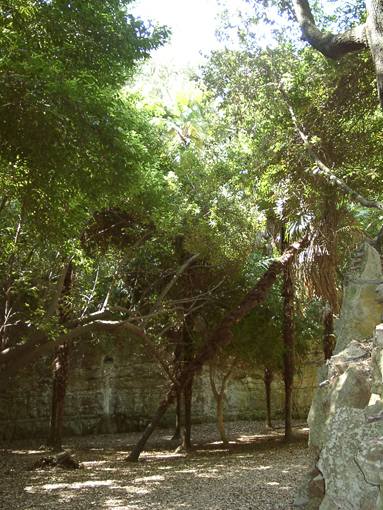
At left a mosaic in the Church
of St. German and the Palm groove (at former horse race course) below
Gradina peak. One couldn't find out whether these palms were planted
by Kupelwieser.
In summer 1894 a convalescent P.K.
returned to his island and started planting various tree shoots and vegetable
seeds he bought from specialized nurseries. Simultaneously works started
to construct few new buildings together to clearing areas for the agriculture
and animal farming. An imported steam engine of 20PS run the electric generator
and geared various power tools in an improvised workshop. Rain water was
collected into repaired cisterns at first and a windmill pumped water from
the natural lake into a new concrete reservoir of 200m³ situated on a dam 10m high. Venetian
left an old narrow gauge railway with small tipping wagons was that was
reinstated to be used for various transports on Veli Brijun. One utilized
the plentiful of stone debris from abandoned quarries to fill up roadbeds
and to build the depilated quay wall consisting of large stones before
only. A proper quay wall and an appropriate wave-breaker have been constructed
with concrete blocks some time later. As from 1899 conservation works started
on ancient ruins and archaeological sites marked for the research afterwards
During summer months the number
of malaria sick people increased rapidly becoming a serious impediment
to the works in progress. According to the local health practice this sickness
was treated with strong dosages of quinine but that was rather expensive.
Despite his diminishing finances Paul Kupelwieser joined a party on 7-week
long visit to Egypt in 1900. He bought there 36 palm
trees with routes and 2-3m high and brought them to Veli Brijun to be planted
there. The palms survived several winters but wouldn’t grow and dwindled
after few harsh winters.
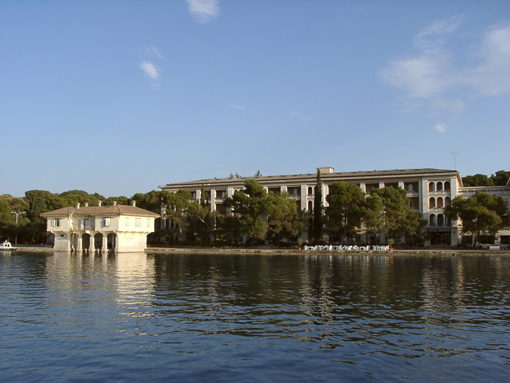

The old ensemble from Kupelwieser's time showing
the promenade in front of the Hotel Neptun (left) and the old Boats
house (right) not in use now.
Kupelwieser read in a newspaper
that Dr. Robert Koch (1843 – 1910) investigates the malaria sickness at
Grosetto near Rome. He wrote to Dr. Koch then in Berlin
about his experiences of malaria on Brioni. Shortly after arrived Dr. Frosch
and Elsner from Koch’s Institute for infective deceases to visit the island.
Instant examinations provided the proof of tertiary malaria cases and an
abundance of anopheles mosquitoes causing this sickness. Soon after Dr.
Koch‘s arrival onto Veli Brijun simple experiments and measures were agreed
upon how to eradicate mosquitoes on the Archipelago. Kupelwieser composed
a long report on the malaria and how to medically treat that illness athat
he submitted to the Ministry of Health in Vienna in January 1902. This unusual
report from a layman about medical matters stirred up some minds in the
Monarchy's Ministries. This particularly as the naval engineering works
on the Archipelago were considerably hampered by losses of workers and
soldiers suffering of malaria illness.
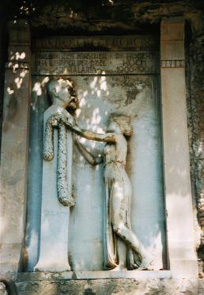 The relief in memory of Dr. Robert Koch who suggested
and effectively helped to eradicate the malaria plague on Brioni Archipelago's
islands. The relief in memory of Dr. Robert Koch who suggested
and effectively helped to eradicate the malaria plague on Brioni Archipelago's
islands.
Dr. Koch came to Veli Brijun once
more in 1902 to see about the progress of sanitation works being done there
in the company of a large number of German doctors too. Following Dr. Koch’s
instructions all pools and ponds as the breeding places of Anopheles mosquito
were filled in and levelled in. Thus the German doctors have learned about
how to eradicate the mosquitoes’ plague on Brioni Archipelago at first
hand. Later they continued with the research on other malaria’s potential
places all over Istria and on a few islands like Lošinj and Cres. There is a mural
depiction of Dr. Koch on a quarry wall above that was one of the largest
mosquitoes’ breeding places on Veli Brijun. There were no mosquitoes on
Veli Brijun since the summer of 1903 and the malaria illness was wiped
out for ever too.
Paul Kupelwieser bought a sailing
boat used by fishermen at Fažana as it was essential to for
an increasing transport to the island. This boat turned out not as
too adequate to move bulky and heavier goods or to navigate to Pula and other harbors further away.
A small steam yacht “Brioni I.” was acquired soon after. After
Kupelwieser’s son Karl received his captain's patent he used “Brioni I.” on his many voyages in the later
years. This yacht wasn’t good enough for transporting bulky goods
like coal or building materials of larger volumes and to be used
as a water cistern. Thus Paul K. ordered a new cargo ship with a
steam engine built in Lošinj so this vessel was named “Brioni
II.” starting its service subsequently. It has been used rather efficiently
and remained unharmed throughout times of World War I.
Despite the rather modest amenities
in a 14-room hotel first guests came to Veli Brijun in 1896 already. From
1903 the number of tourists increased significantly and among them were many of Monarchy’s
noble and honourable persons. Thus a more comfortable vessel was needed
for regular services to and fro to Pula harbor and to others harbors on
the coast of Istria. Inventive Kupelwieser ordered
a new ship that had to be driven by a fixed Diesel engine and was the first
of its kind in the shipbuilding worldwide. His third ship “Brioni III.”
had its home harbor at Brioni and had provided postal and local travel
services throughout many decades. This remarkable ship had survived both
World Wars although under different names and sailed well into 1960s too.
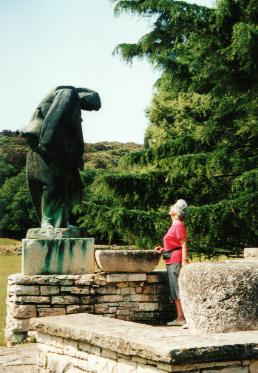
This modern monument to "The Water Bearer" was erected
during times when Brijuni islands were Marshal Josip Broz Tito's chosen
summer residence. At those times the whole Archipelago was the restricted
zone and the only visitors were guests of the Yugoslav Governement.
The water became in short in supply as number of tourists increased
as well as the requirements for farming on Veli Brijun. Kupelwieser bought
a cavern system near of Fažana from that high stand one pumped
water through a pipeline of 3.200m length laid on shallow sea floor to Veli
Brijun. The pipes were made of cast iron and had been isolated with 3 layers
of Indian hemp soaked in asphalt to prevent
corrosion by sea water. The increased demand caused problems soon because
the water became brackish partly influenced by tidal movements too. In the
meantime City of Pula planned the water supply from
deep well near Galižane that Romans had been using
long times ago already. By extending and linking Brioni pipeline to Pula water supply system in 1908 Kupelwieser
solved the main problem although the repair costs for the pipeline went up
with its age.
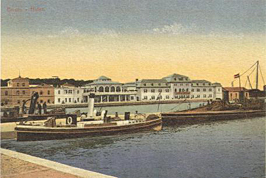
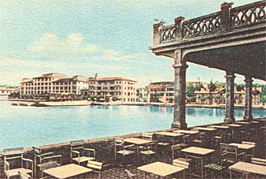
Above
two postcard pictures were printed in 1912. The passenger ship "Brioni
III" and the cargo carrier "Brioni II" moored at main quay in front
of Hotel "Neptun" and Hotel "Carmen" in background left. The view to Hotel "Neptun" from the promenade of
Hotel "Carmen" (right).
During coming years the construction works began for larger hotels
and 4 hotels with a total of 320 rooms and 10 villas were completed by 1913.
The hotel compound “Carmen” was built close by the hill of same name and north
of other hote one named “Neptun” was located inside the harbor south side. Next
to all these construction works one built a new quay, a post office & telephone
switchboard, created some 50km of roads and paths and formed a beach side with
180 cabins, made an indoor swimming-pool with heated sea water, a casino, run
a stud farm and prepared various sports grounds as well as the largest golf course
in Europe (18 holes and 5850 m of paths)
of those times too. Vineyards and olive plantations products were appreciated
the same like the milk and the excellent cheese on island own pastures. The Brioni
Archipelago has been advertised as the climatic and wellness resort and printed
a weekly newspaper too. The season lasted almost the whole year
round and the standing of guests confirmed the social prestige status for the
holidays on Brioni. However during the war period from 1914 to 1918 some 2.600
soldiers were stationed on the Archipelago’s islands.
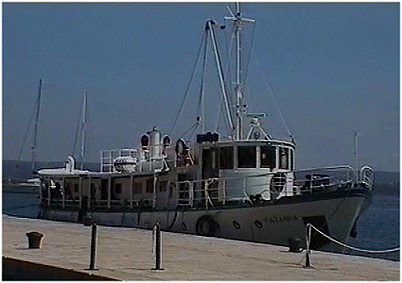
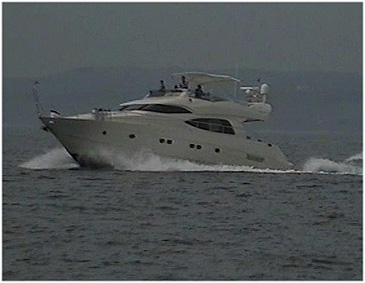 MS "Fazanka" provides the transfer of tourists from
the mainland Fazana harbor to the Veli Brijun island (left) and the speed
boat stationed at the island at right.
MS "Fazanka" provides the transfer of tourists from
the mainland Fazana harbor to the Veli Brijun island (left) and the speed
boat stationed at the island at right.
Ingenious and untiring Paul Kupelwieser
has had many more ideas and plans to develop the southeast and southwest
coasts of Istria that the Monarchy has neglected
so far. In Medulin harbor he thought one could construct a shipyard contributing
its service to the Monarchy’s naval base in Pula. Also he suggested a daily ship
connection on the relation from Medulin to Zadar via Lošinj. He recommended the construction
of 20km railway line from Zadar to Šibenik that was to be linked to
the main railway to Split and Zagreb respectively. In this respect
Kupelwieser bought Vižula peninsula there thus securing
an adequate stone quarry and several fresh water wells too. He negotiated
also possibilities to establish an oil terminal and a quick-lime production
close to Pula. Near Valtura he found a large
area that could be turned into vineyards and intended to buy large plots
for his faithful cooperator Alois Zuffar but the later died before that.
However
the First World War interrupted all Kupelwieser’s plans to turn the Brioni
Archipelago into a perfect tourist attraction. When this war ended whole
of Istria including
its islands came under the Italian sovereignty but the
Brioni Archipelago remained the possession of Kupelwieser’s family. Due
to the increasing and stronger tourist competition Kupelwieser’s enterprise
went bankrupt in 1936 and came under the jurisdiction of the Italian Ministry
of Finance. Soon after a daily hydroplane connection to Brioni had been
introduced but the Second World War ended
this new period of tourist prosperity abruptly. Again the Brioni Archipelago
became a naval fortification and came under aerial attacks several times
in the wake of Second World War. In a bomb raid on April 25,
1945 two hotels,
many houses and a large part of the quay were badly damaged or destroyed.
Literature
used:
1. THE NATIONAL PARKS OF CROATIA by Ivo Bralic; translated
from Croatin by
Vladimir Ivir & Nikolina Jovanovic; ISBN 953-060580-3
(ŠK); 1995 Zagreb.
2. “Aus
den Erinnerungen eines alten Österreichers“ Paul Kupelwieser Brioni, 1918
Gerold & Co.,
Wien I, Stefansplatz 8.
The special edition „HISTRIA HISTORICA” Vol. 5 – Paul
Kupelwiser “From reminiscences
of an old Austrian – Brioni / Brijuni
/ Pula 1993. Copyright 1993 by the Society
for History and
Cultural Development of Istria, Pula (Croatia); ISBN 0351-1626. This Edition
contains the
original text in German by Paul Kupelwieser
and the Croatian translation of the same.
Related web page:
prof. dr. Jadranka Skorin-Kapov, New York: A
short historical overview of Istria and, especially, Pula
DISCLAIMER : On URL: http://www.cosy.sbg.ac.at/~zzspri/ published
pages are originals and authorized by copyright of Zvonko Z. Springer,
Salzburg 1999.
Email Zvonko Springer at : zzspri@aon.at
Croatia - its History, Culture and Science
|


 A part view of the famous AMPHITHEATRE interior
at Pula that is located next to the large Yacht harbor.
A part view of the famous AMPHITHEATRE interior
at Pula that is located next to the large Yacht harbor.
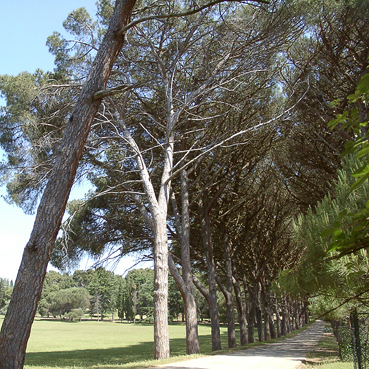
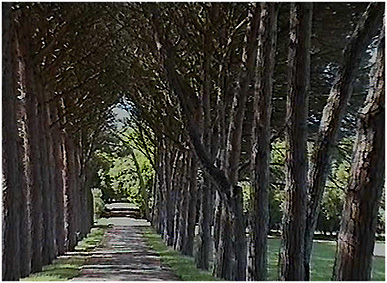














 The relief in memory of Dr. Robert Koch who suggested
and effectively helped to eradicate the malaria plague on Brioni Archipelago's
islands.
The relief in memory of Dr. Robert Koch who suggested
and effectively helped to eradicate the malaria plague on Brioni Archipelago's
islands.



